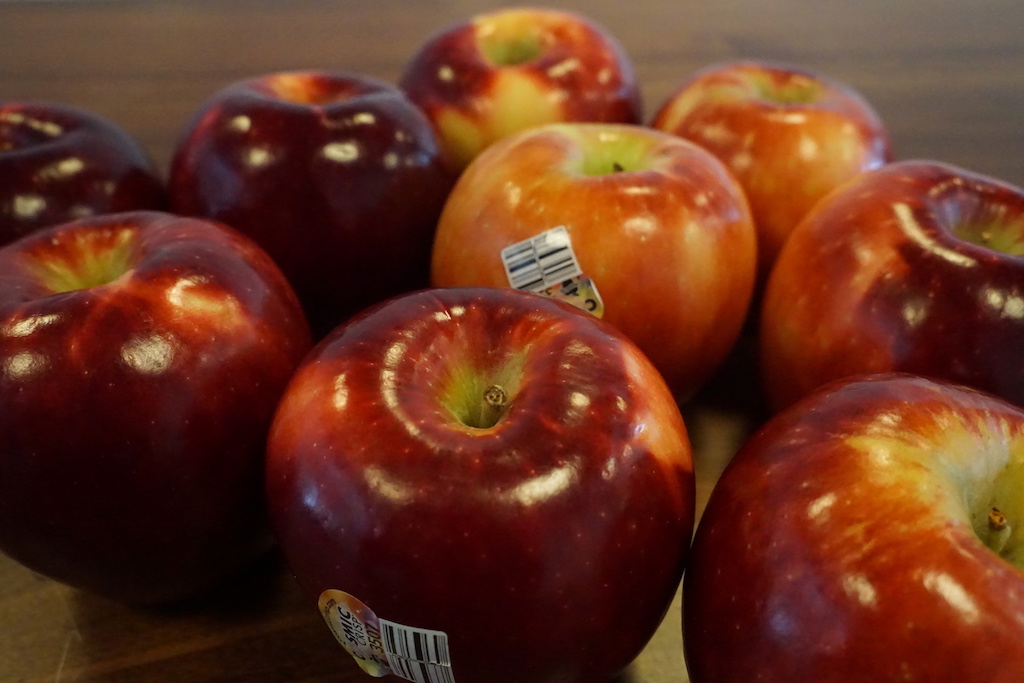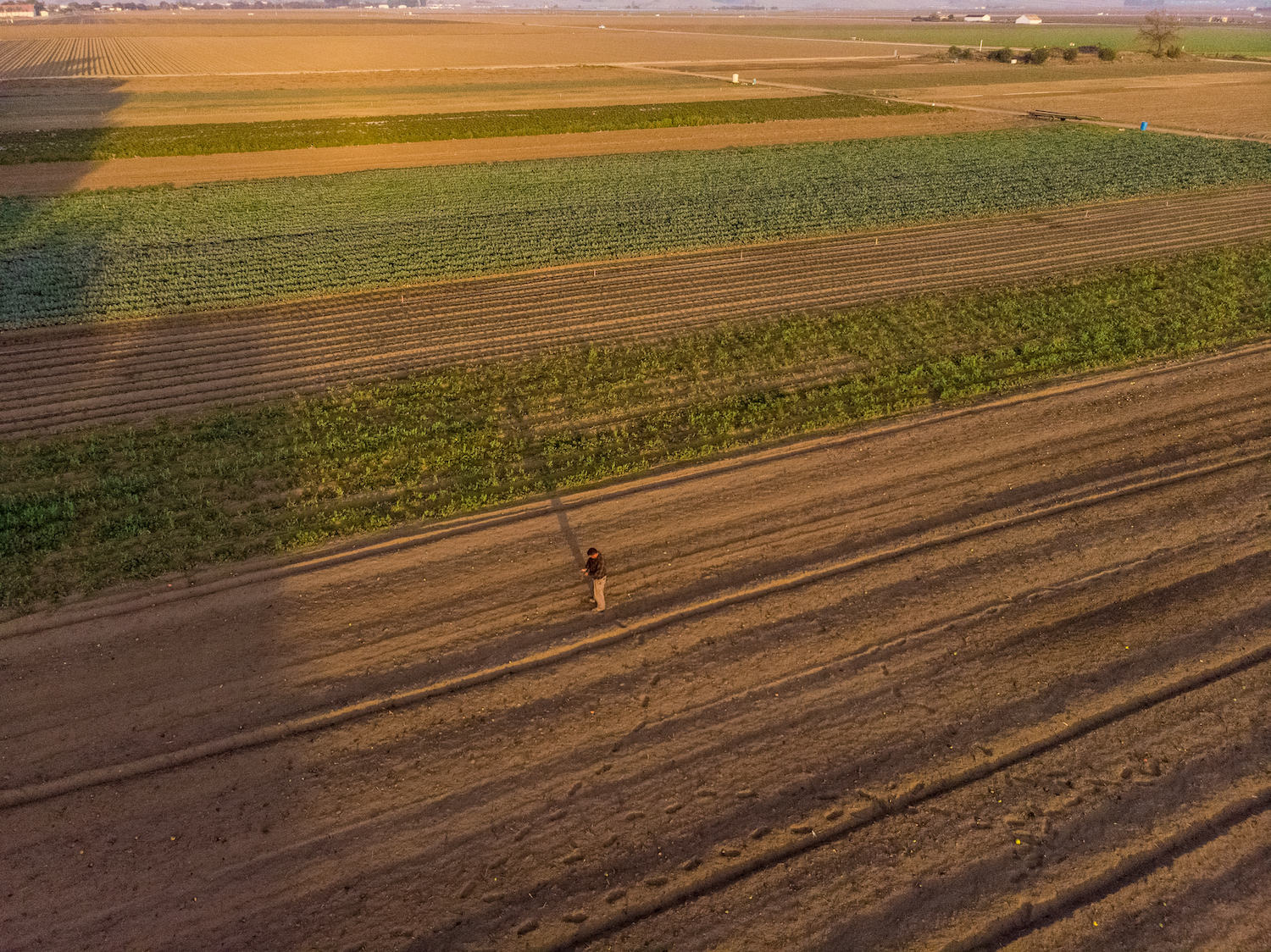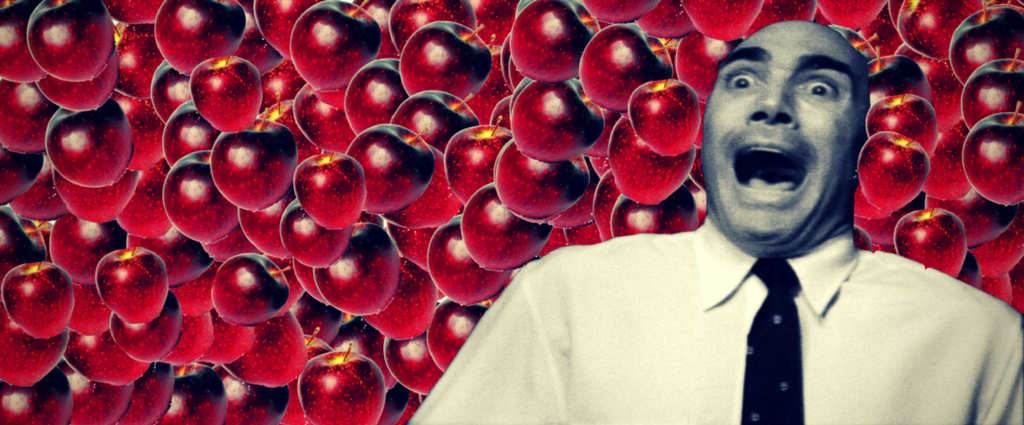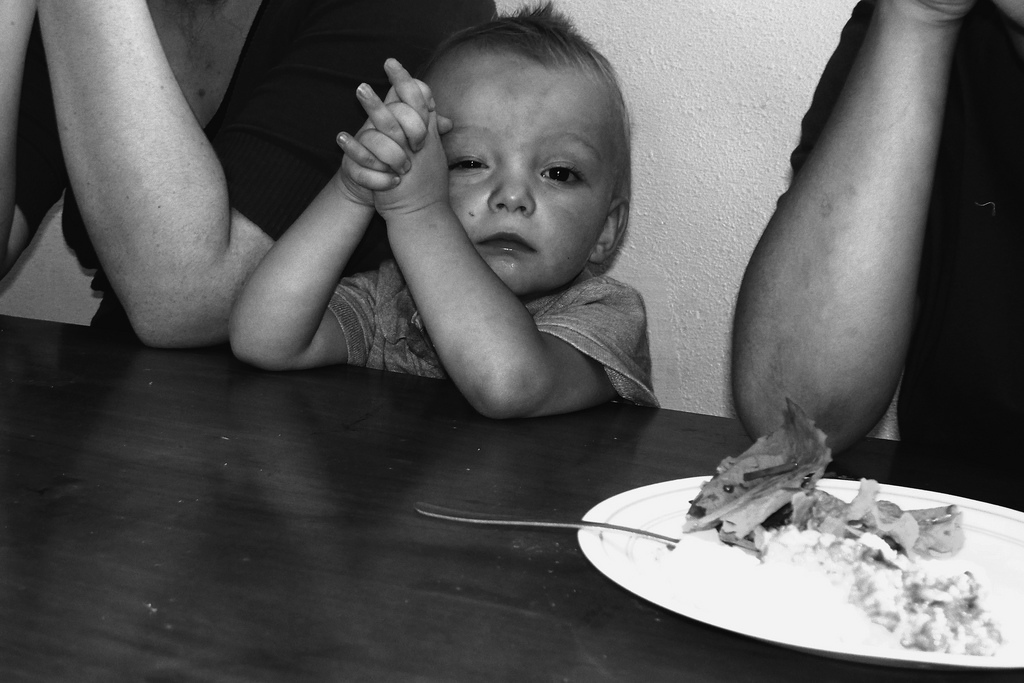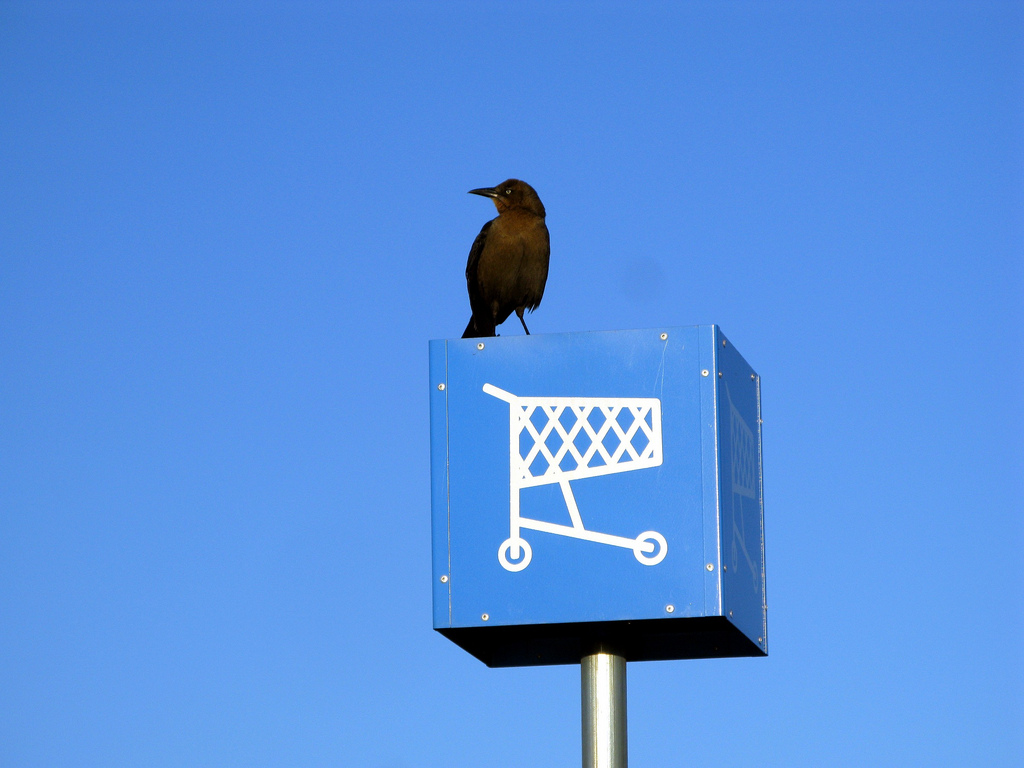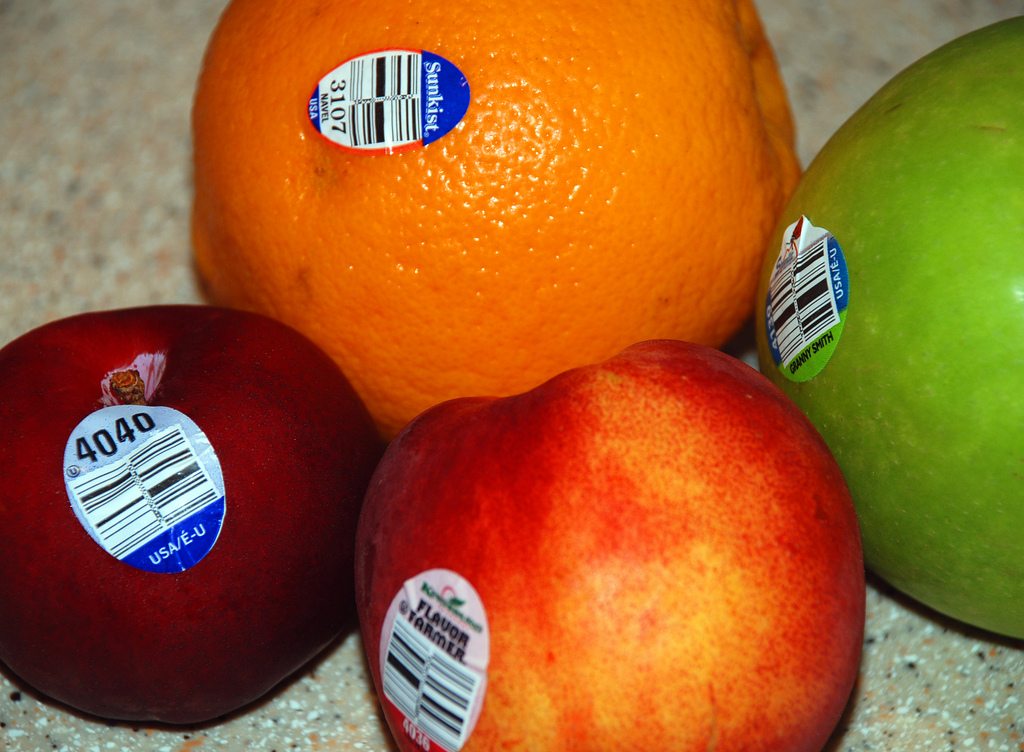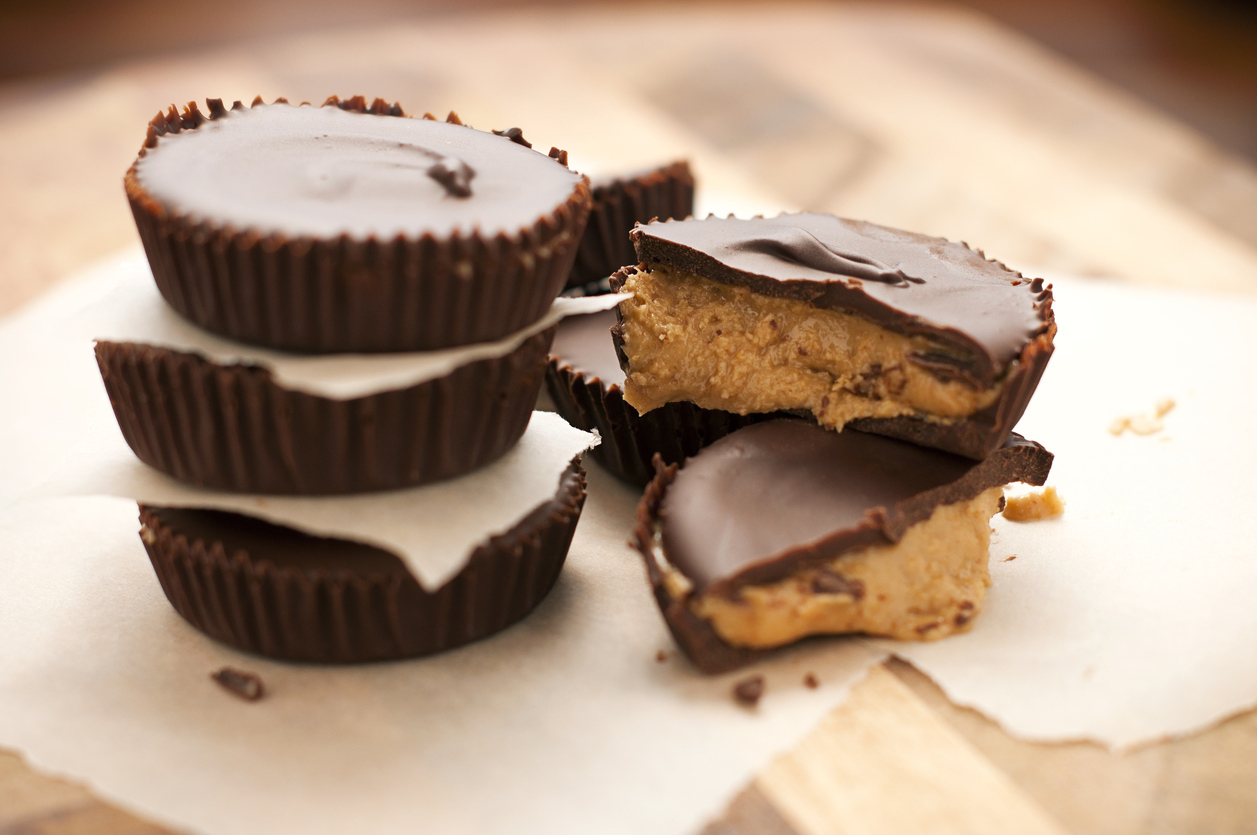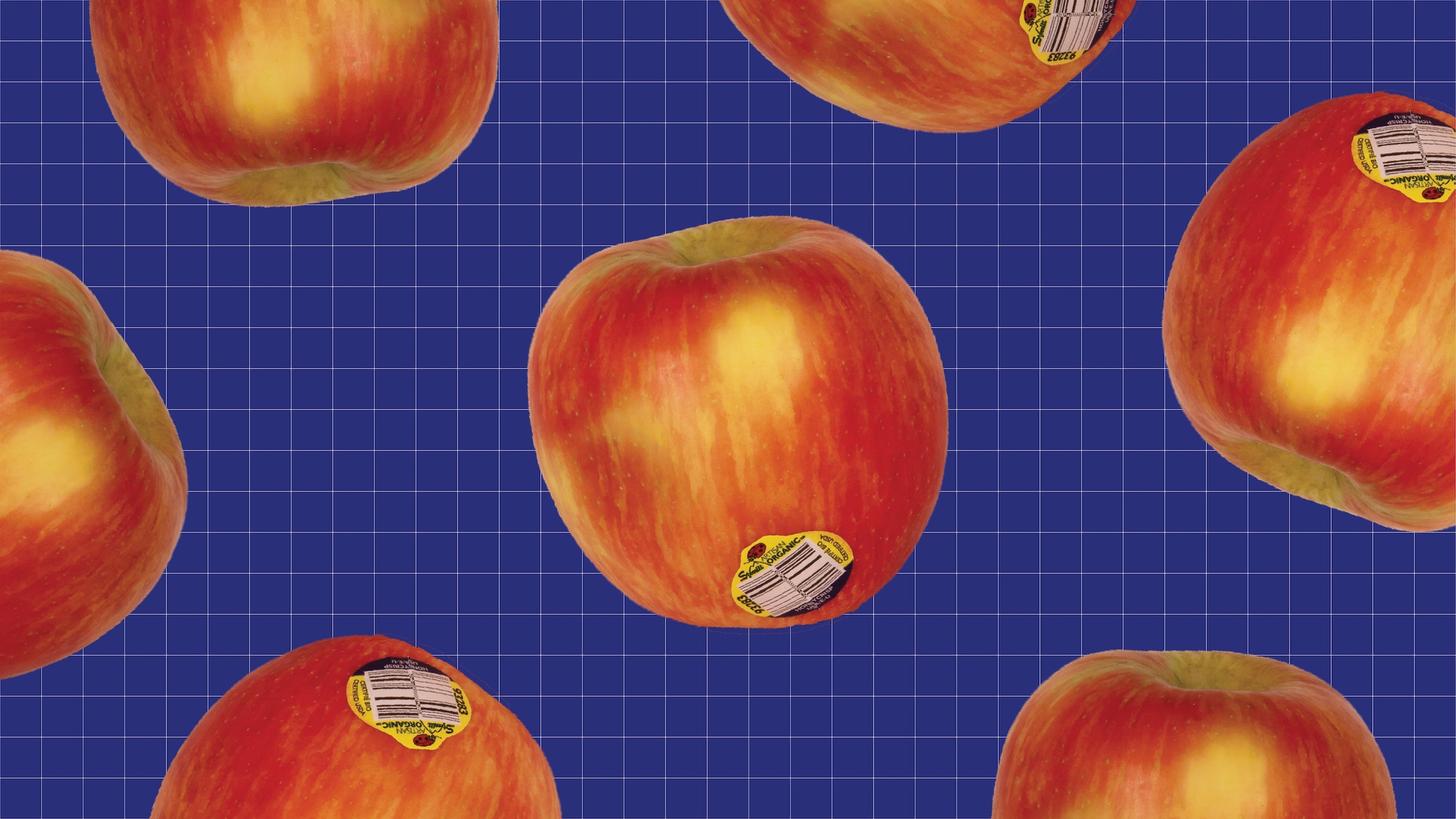
Flickr/Mel McC/ Graphic by Talia Moore
Cosmic Crisp apples, Cotton Candy grapes, and Cuties are among the most fiercely protected fruits in the global IP marketplace.
Now is a good time to imagine a peaceful scene. Here’s one: In an overgrown field, a wizened, knobby tree hunches in the sun. In spring, it’s festooned in white flowers that eventually drop; in their place, small, hard, spotty fruits slowly swell.
Here’s another: In a grassy, sweet-smelling orchard set across gentle hills, diminutive trees stand in tight rows. In between their leaves burst clusters of large, ruddy, unblemished fruits, ready for harvest.
Both the solitary tree and the orchard trees bear apples and are members of the ancient genus Malus that originated in Central Asia. Other than that one detail, though, they don’t have much in common.
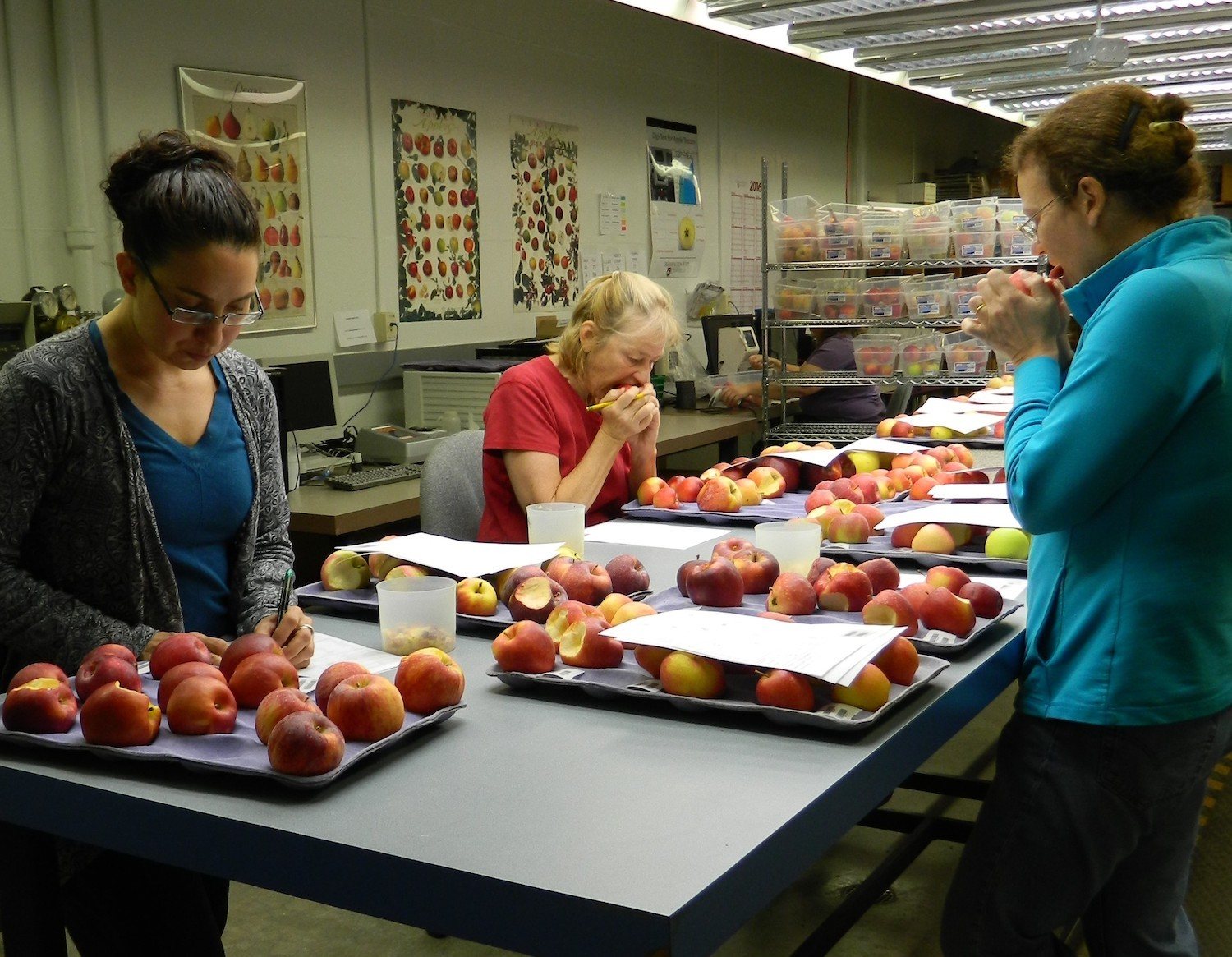
Kate Evans, a pome fruit breeder at WSU, tasting breeding selections in the lab
Washington State University
The first tree likely sprung up wild after a bird pooped out the seeds of some gobbled fruits. Bitter, astringent, possibly mushy, decidedly unlovely, its apples interest only woodland animals and, possibly, an energetic cider maker looking to concoct a complexly flavored brew.
The orchard trees are cultivars developed by breeders over as many as 15 years, then produced in nurseries by grafting twigs, called scions, onto rootstocks. Crossing species traits, breeders aim for an “eating profile”—crispness, sweet/acid balance, maybe a novel anise flavor—that consumers will flip for. Intense marketing campaigns accompany some of these apples’ arrivals in the supermarket. Envy, Pink Lady, and the hotly anticipated Cosmic Crisp developed by Washington State University (WSU) and released last year: These are patented, trademarked brands, grown under licensing agreements, that generate a lot of buzz and, potentially, even more revenue.
[Subscribe to our 2x-weekly newsletter and never miss a story.]
These days, not just apples but many of the grapes, cherries, apricots, plums, peaches, berries, oranges. and pears we eat are protected by intellectual property (IP) frameworks of one kind or another. Some detractors say the tilt towards IP represents a bid by powerful companies to take unreasonable control of our food system. Proponents, though, say IP is essential to keeping an ever-more global fruit industry alive and flourishing. And some players are willing to take legal action to protect what’s theirs.
The roots of fruit IP
American breeders have long used the concept of IP to protect their fruit varieties against piracy; in the mid 19th-century, that meant illustrating and cataloging them, according to Smithsonian Magazine.
The Plant Patent Act of 1930 made it possible for breeders to more formally protect a cultivar reproduced asexually, which means it’s made, not from seeds, but from pieces of a “mother” plant so that all offspring are identical clones that yield identical fruits. To score a plant patent, a cultivar had to be genetically new, “distinct, uniform, and stable,” according to the United States Department of Agriculture’s Office of Technology Transfer. Such a patent is granted by the U.S. Patent and Trademark Office and lasts 20 years.
“It means someone can’t take your plant, produce thousands of it, and not pay for it.”
In a common scenario, a patent is held by a breeder, whose institution, via its technology transfer office, grants a license to a nursery to reproduce trees. Commercial growers who buy them pay a royalty of $1 to $4 per tree. “It’s a way to control propagation,” said Cornell University berry breeder Courtney Weber. “It means someone can’t take your plant, produce thousands of it, and not pay for it.” It’s also a way for a university to recoup some of the money spent during the lengthy breeding process: developing plants, growing them out, selecting those with promise, conducting field and consumer trials.
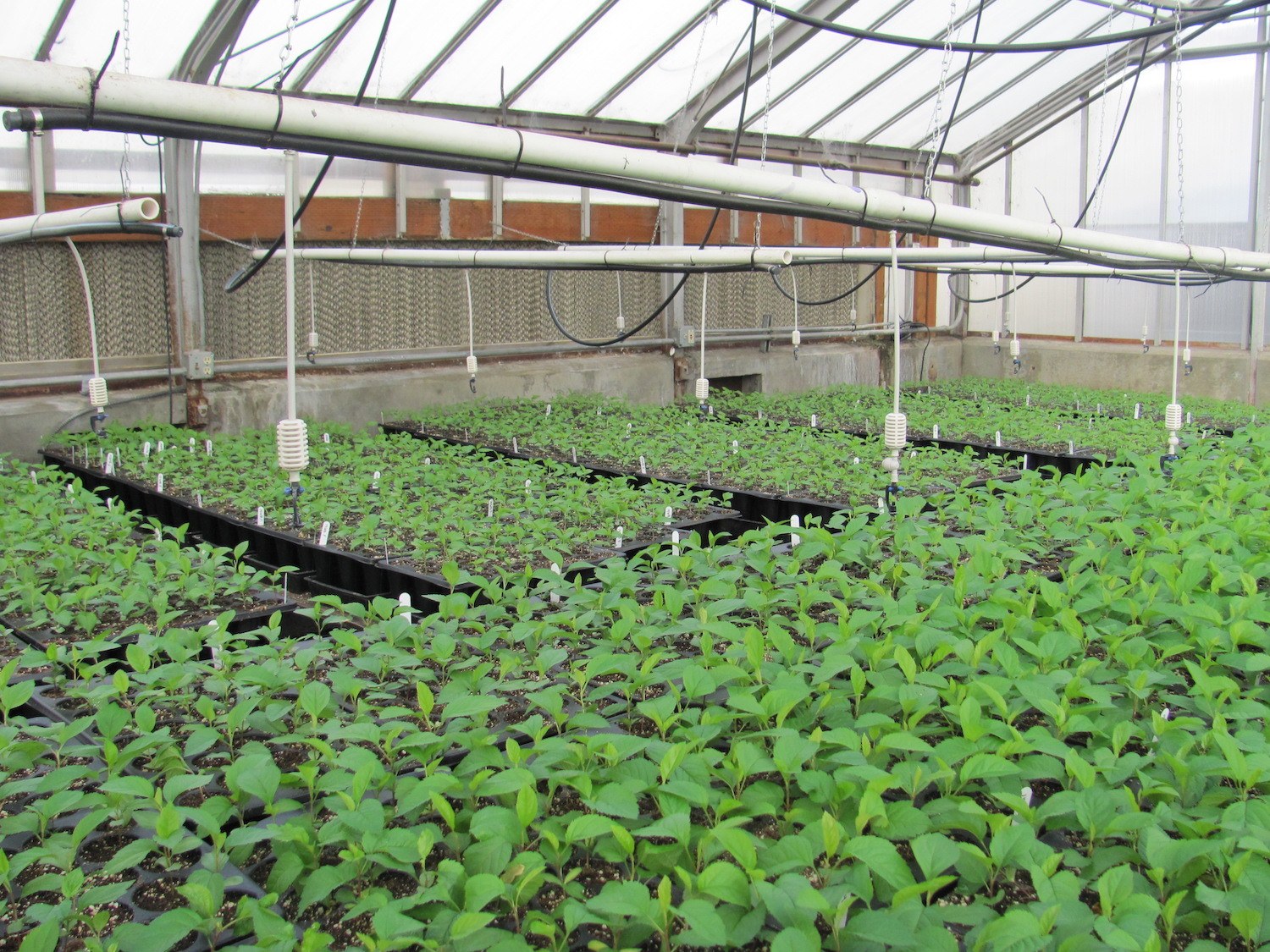
Newly germinated seedlings in the greenhouse at WSU
Washington State University
Patents for fruit weren’t pursued much for the first 40 years of the Act. “When I got into the business in 1975, a university breeder would find a good variety and allow nurseries to propagate it” for free, said Phil Baugher, president of Adams County Nursery in Aspers, Pennsylvania, which sells apple, pear, plum, peach, nectarine, and apricot trees to growers—most of which are, or once were, patented.
That changed with 1980’s Bayh-Dole Act. The Act made it possible for federally-funded organizations like land-grant universities to hold onto the title of their inventions; they were now free to patent and license those inventions and to make income off of them from the private sector. Land-grant breeders teamed up with growers to produce fruit they could both enthusiastically throw their weight behind. Fruit like the big, juicy, crispy Honeycrisp apple out of the University of Minnesota, which had its patent filed in 1988, hit the market in 1991, and by 2014, was a consumer favorite. Bayh-Dole was the start of a trend, wrote Los Angeles Times’ David Karp, of land-grants acting “less like researchers and more like businesses.”
What’s in a patent?
The U.S. grows over 11 billion pounds of apples a year; they’re our most-consumed fruit. But patents have become de rigueur for other clonally produced fruits, too. And they don’t just benefit universities. The U.S. berry industry, for example, is dominated by Driscoll’s, a private company that develops cultivars in-house. They flourish at different times of year, in different settings and locales, in order to keep full berry boxes on produce shelves all year long.
“Only Driscoll’s growers can access Driscoll’s varieties, but the growers don’t own the plants—they just rent them for the season,” said Weber.
The USDA, too, files patents for some fruits it releases, like three new peach varieties meant to help southeastern growers adapt to a warming climate. Peach names are virtually unknown to consumers; that makes them interchangeable under supermarket PLU codes, to give the short-lived peach season longer legs.
“Only Driscoll’s growers can access Driscoll’s varieties, but the growers don’t own the plants—they just rent them for the season.”
Unsurprisingly, where there’s revenue at stake, lawsuits follow—despite the fact that Baugher says within the U.S.’s insular fruit industry, growers can’t afford to be “the guy caught stealing, because you will be shunned.” But theft still occurs, as in the case of California growers who in 2001 illegally obtained and propagated two table grape varieties developed and owned by the USDA.
Patent law also covers wonkier issues. In 2017 and then again in 2019, a well-known private strawberry breeder was sued—first by his former employer, University of California, Davis, for using genetic materials he created while working for the university (the university won); then by his competitor, Driscoll’s, for developing “progeny that resulted from unauthorized crossbreeding with Driscoll’s proprietary strawberry varieties,” the second lawsuit alleged.
Should growers be allowed to produce a patented fruit variety developed by the land-grant university in their state? Growers in Minnesota thought so, and sued the University of Minnesota over the right to grow SweeTango apples (the growers lost).
Another thorny issue: It takes at least five years to get a new fruit to market and even longer to get consumers demanding an apple by name at the store. “We get fan mail on some of our varieties, but that didn’t always happen,” said Susan K. Brown, longtime apple breeder at Cornell University. Her program has released 65 apples since the late 1890s, with three more on the way. By the time momentum has reached a fever pitch, the patent has likely expired and with it, a breeder’s right to royalties. This happened to Honeycrisp, the patent for which expired in 2008 and which fruit folks recall with an audible shudder.
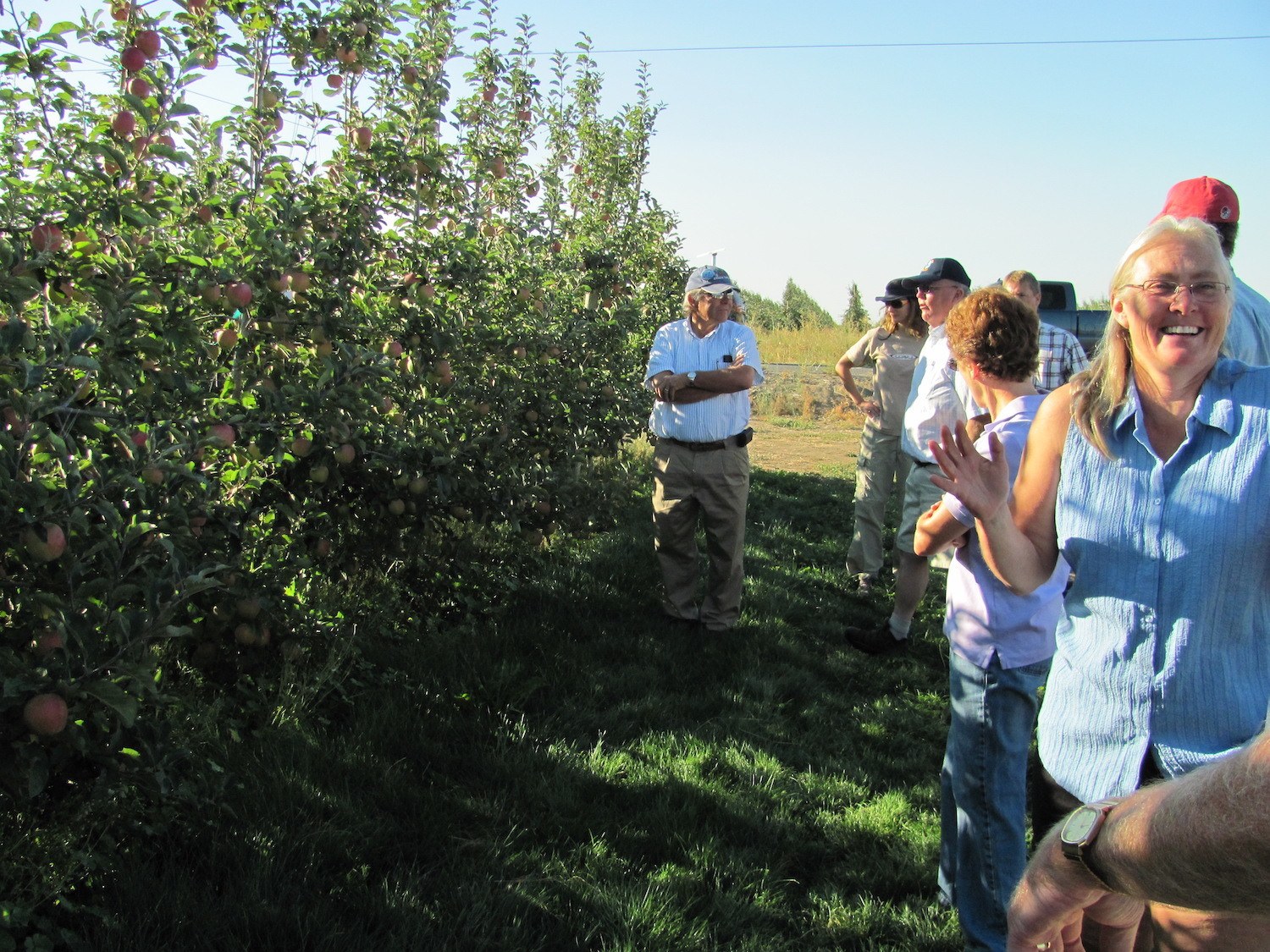
A group of Washington apple growers discussing pros and cons of new selection trees, providing input for Kate Evan’s decisions whether to release them or not as new varieties
Washington State University
Enter trademark
“A trademark is a whole ‘nother landscape,” said nurseryman Baugher. “The whole idea is that the fruit itself is a brand, and you market it under that brand name,” he said. “Anyone can produce cola but they can’t market it as Coca-Cola.”
A registered trademark technically never expires, even after the patent has. That means someone could grow a mandarin orange cultivar once its patent is up; they just couldn’t sell it under the Cuties name, which is a trademarked mandarin brand that commands a premium price.
The trademark’s real power comes from the promotional push behind it, which ensures that all costs—from registering a fruit with the patent office, to hiring a company to come up with an ad campaign—pay off. “If you can develop a market based on a brand, that enhances the chances to do well into the future. Growers are beginning to appreciate that; they put $30,000 to $50,000 into every acre of orchard and they don’t want to pull that up because it’s become economically non-viable,” said Bill Howell, manager of fruit nursery organization Northwest Nursery Improvement Institute (NNII).
“The whole idea is that the fruit itself is a brand, and you market it under that brand name.”
For the whole brand caboodle to work, “you need something unique, with very high quality” to compete with some 50 other branded apple varieties, said Baugher. A breeder might license a nursery to produce trees to sell to eligible growers, possibly members of a “club” who have exclusive rights; royalties are collected both on bushels of fruit sold and on each tree. The nursery probably hires a managing company to file for a patent and a trademark, plus secure similar rights around the world, then make sure growers are producing fruit according to rigorous specifications—a so-called managed variety.
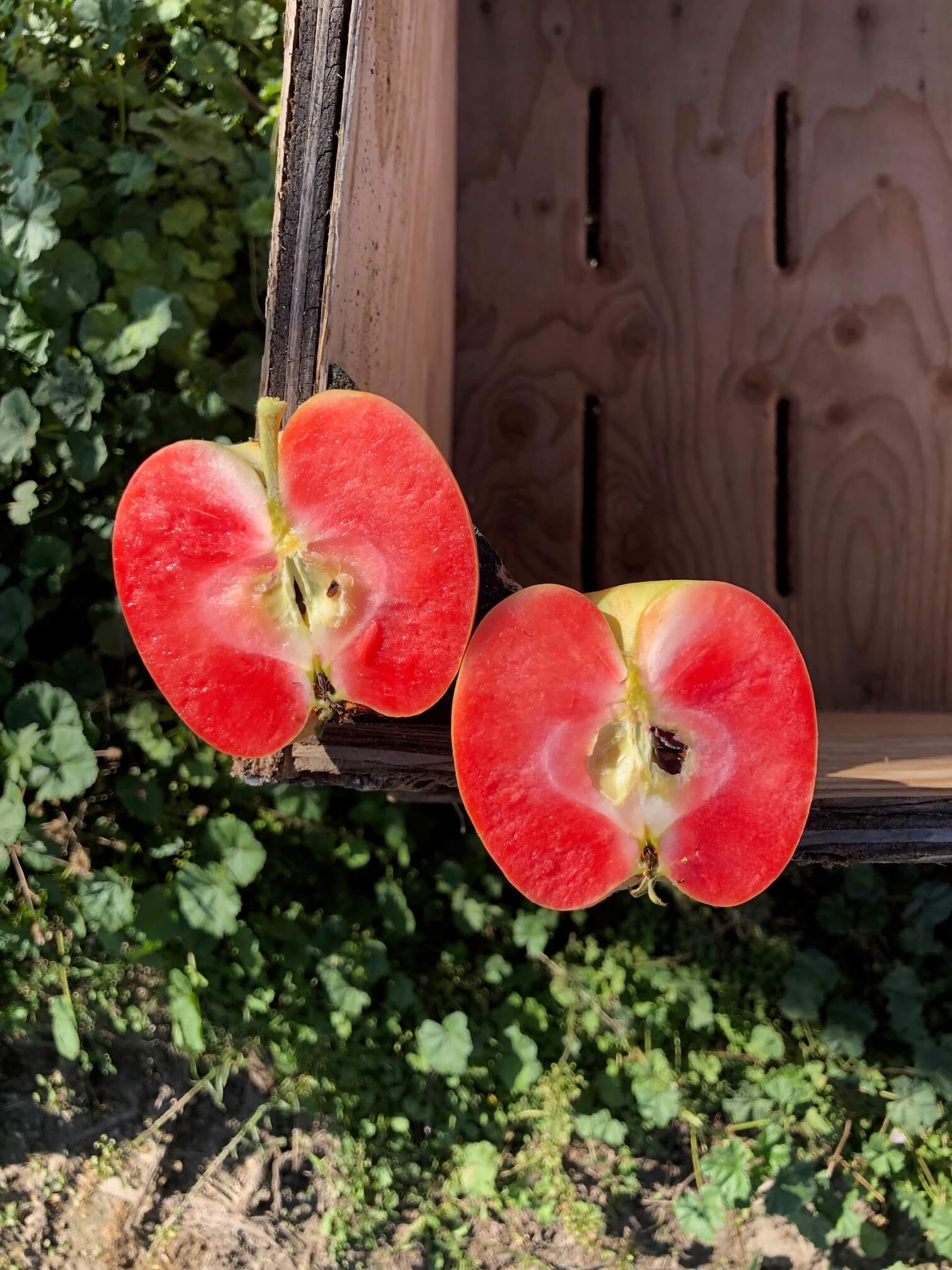
Proprietary Variety Management
A new branded red flesh apple, the Lucy® Glo.
Breeders of these sorts of “commercially important varieties,” said Edgar Krieger, secretary general of trade association International Community of Breeders of Asexually Reproduced Horticultural Plant Varieties (CIOPORA) based in Geneva, are the ones who “might consider going to court.”
The benefit to consumers of managed fruits is that “they receive a good consistent quality product under that brand and know they can trust it,” said Howell. NNII’s 13 members have exclusive, 10-year rights to grow Cosmic Crisp apples in North America. Brown at Cornell is releasing two varieties—RubyFrost and SnapDragon—to New York State growers who are members of the Crunch Time Apple Growers club.
She’s confident about the apples’ future. “SnapDragon is going to take over the market for Honeycrisp,” she said.
Some in ag aren’t convinced this is the right direction for fruit. “My biggest argument against [managed and] club varieties is I’m not sure small growers can afford that,” said Lesley Judd, a plant scientist at the State University of New York at Cobleskill. “I see it as turning slightly into a monopoly on certain types of apples.”
Enforcing IP
Trademarking is especially applicable to apples, which people know by name and which are found in stores all year long under that same name. Kate Evans, a pome fruit breeder at WSU, said she sees similar opportunities for pear cultivars to become hot commodities—we know them by name, too, and they can also be stored for months. But while there are some trademarked pears already, lack of a decent dwarfing rootstock (rootstocks are also patentable and trademarkable) makes it expensive for growers to produce new pears on a large scale.
Grapes, though—patents for 100 varieties of which were sought in the U.S. in the last five years—are on their way, with a legal battle to prove it. American company IFG—developer of the now-supermarket-ubiquitous Cotton Candy grape—undertook “enforcement actions” against Chinese growers for IP infringement on six of its grape varieties, according to a statement released by the company’s PR firm. IFG declined to comment for this article.
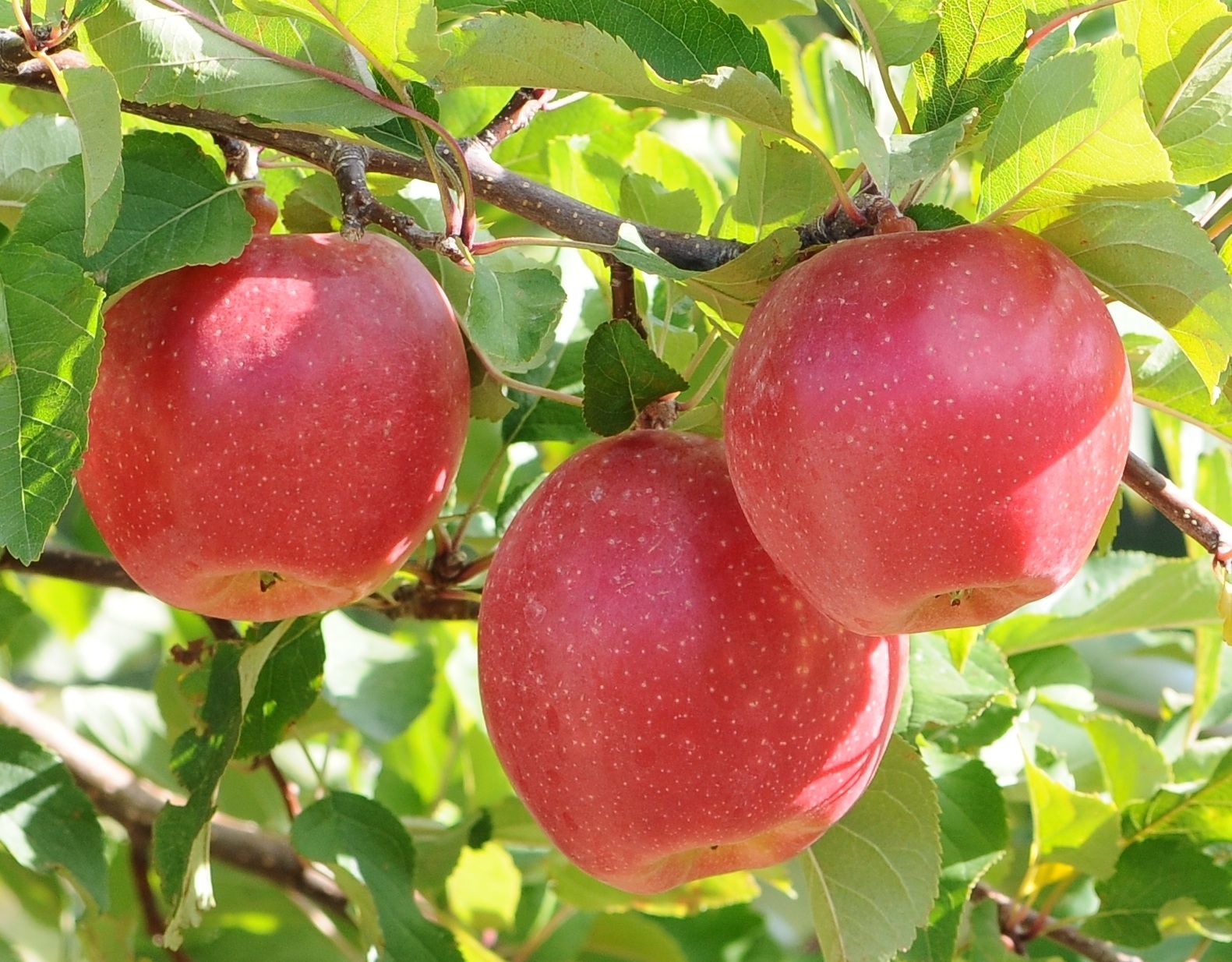
The apple variety trademarked Sunrise Magic that came out Kate Evan’s program at WSU
Washington State University
“Lawsuits are on the rise for all crops, since [the field] is getting more and more international and there are so many more players taking part in commercializing,” said Krieger. Advances in DNA analysis can help make infringement claims easier to prove than they once were, but you have to catch an infringer first.
Lawsuits also come with risks. Courts in some EU countries are critical of proprietary rights on live materials and “regulate them strictly,” Krieger said. Even when a breeder wins, the suit likely costs more than he recoups which means breeders might choose to sue only if they think it’s worth it to send a message to future potential infringers, and after cheaper tactics—settlements for damages, making an infringer uproot his plants—have been tried and failed.
Fruit patents aren’t likely to fall out of favor, according to Brown (except in Europe, where plants obtained by “essentially biological processes” were deemed un-patentable by the European Patent Office’s judicial board; weaker Plant Variety Rights remain, though, and are enforceable country-by-country). With global markets twinkling brightly and invitingly in the distance, the NNII bunch is feeling bullish. Twenty-five percent of U.S-grown apples are shipped internationally and “those markets have demands that need to be met,” said Howell.

